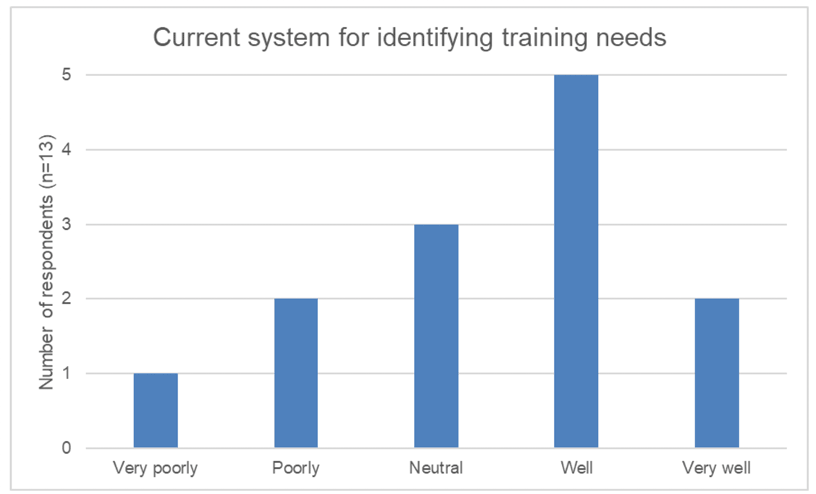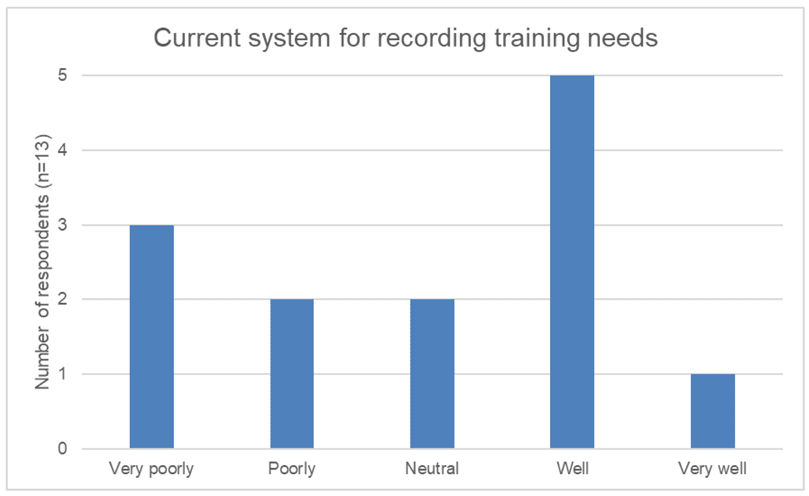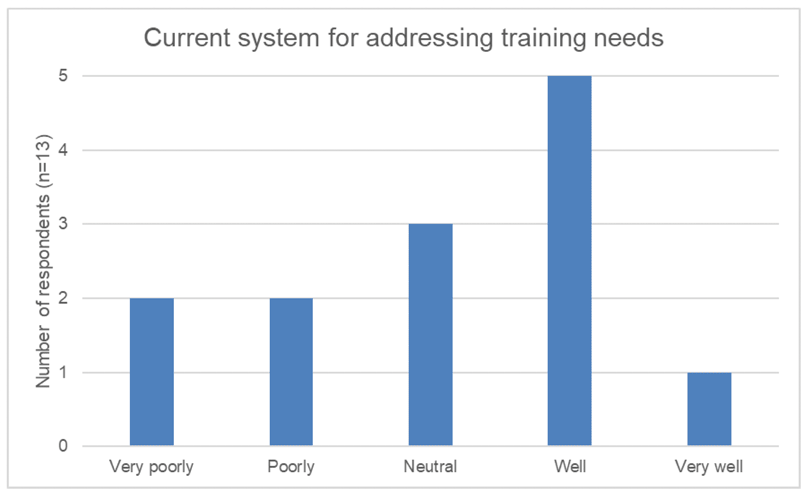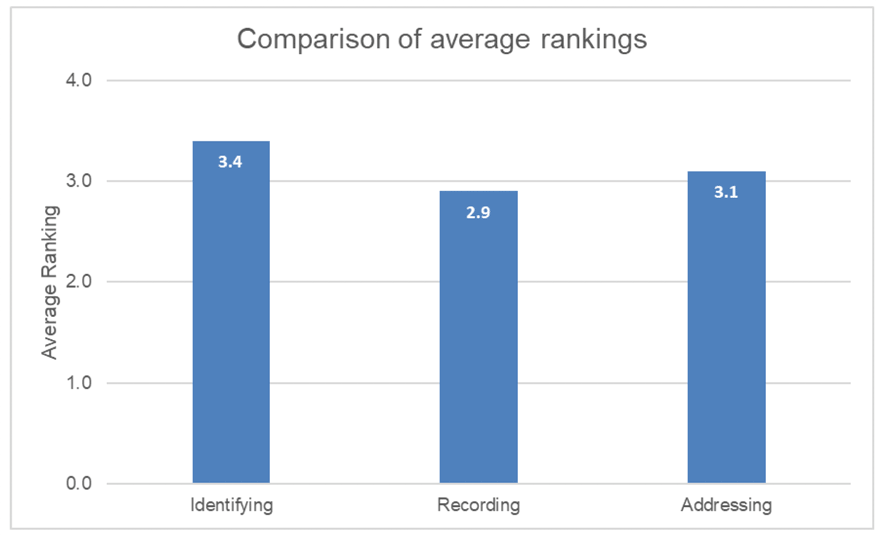Building standards - verifiers management and training and development recording: review
A study to investigate how the recording of training needs identified through the Competency Assessment System (CAS) is managed. Also how the current systems and processes can inform the development of a learning and development hub for the building standards profession.
This document is part of 2 collections
2. Overview of Existing Processes
2.1 Introduction
2.1.1 This section sets out the current processes for recording training and development needs for building standards staff and draws on the responses to the online survey.
2.2 Identifying Training and Development Needs
2.2.1 All 13 local authorities undertake an annual review to identify the training and development needs of building standards staff. These reviews can take a number of names including Performance Development Review (PDR) and Employment Review and Development Process (ERDP). Five authorities have a six-monthly review, one authority has a three-monthly review and one has follow-up where required.
2.2.2 All authorities used generic local authority forms as part of the review process. One authority can cross reference the form to RICS competencies where required and another can also consider core competencies, personal and professional issues and requirements.
2.2.3 The majority of authorities used the forms on a self-completion basis which were then discussed with a face-to-face follow-up. All authorities had face-to-face meetings. A couple of authorities highlighted that the review/appraisal would be "signed off" and checked by more senior managers e.g. the line managers manager. For most authorities the main people involved in the appraisal process are the member of staff and their line manager. This could be a team leader or building standards manager depending on the size and set-up of the building standards department. A couple of authorities highlighted that the training needs for building standards staff are collated and delivered as part of an annual training plan. One authority also highlighted that any training needs are also identified in their "skills audit" which is monitored on a regular basis.
2.2.4 The role of human resources (HR) in the process is limited but can vary across authorities. A few authorities indicated that HR played no role in the process, a few stated that HR played more of a monitoring role to ensure the reviews are undertaken and a few highlighted than HR would only be involved if advice or assistance is required. One authority had involvement from HR to setup the appraisal in specific[1] software.
2.2.5 One authority commented that staff are continually monitored with workload reviews highlighting where possible shortcomings in professional competency are evident. Weekly team meetings are also being helpful in highlighting specific training needs. Another authority felt that the appraisal process was worthwhile in looking at competencies for the role, identifying skills gaps and putting action plans in place to address the gaps.
2.3 Process for Recording Training Needs
2.3.1 Training and development needs tend to be formally recorded in the specific local authority appraisal form. However, there was variation in terms of where these forms are stored. Some authorities retain this form within the building standards team while others store the forms in HR records/systems.
2.3.2 In terms of systems used, nine authorities referred to Microsoft Office packages (including SharePoint) with a few respondents identifying other software –Pentana, Resourcelink Online, People Connect and MyPeople. The latter three packages are understood to be HR software.
2.3.3 None of the packages used for recording training and development needs across all responding authorities are linked to any building standards specific software.
2.3.4 For the majority of respondents, these training and development needs are not shared elsewhere in the authority. One authority referred to information being stored within the wider service and another referred to information being shared with other services and corporately.
2.4 Responsibility for Addressing Training Needs
2.4.1 For most authorities, ensuring training needs are addressed is the joint responsibility of the member of staff and their manager. Occasionally the building standards manager/service manager may also be involved. One authority described internal training as being primarily "on the job" training with external training mainly delivered via LABSS and the consortia groups.
2.4.2 The responsibility for addressing training needs however, can vary depending on the type of training required and if there is a cost involved. Some respondents highlighted that external courses would have to be approved by the building standards manager and that it would be the responsibility of the manager to ensure that adequate budget is available. One example was provided of a manager having to seek support for training funding from the corporate learning and development team.
2.4.3 One authority noted that any requests for training which do not incur a cost are usually approved regardless of whether it has been approved during the performance appraisal. Another authority highlighted than all staff can request to attend any reasonable CPD event and that there was regular in-house training provided.
2.4.4 The majority of respondents (eleven) identified a role for a central corporate learning and development team, although there were some qualifications surrounding their role. A few respondents specified their a role as being the delivery of mandatory corporate training. One authority stated that corporate training was delivered remotely via the iLearn platform[2] while another authority made reference to an online training hub for generic, non-technical matters.
2.4.5 A further authority identified that the central learning and development team can arrange whole team training courses (e.g. working at heights) and were responsible for promoting apprenticeship schemes and attracting people to further education courses.
2.5 Recording Training Needs Identified Outside the Formal Appraisal Process
2.5.1 Of the 13 respondents, five stated that there was a process for recording training needs identified outside the formal appraisal process. These processes included:
- Monitoring development and on-going discussions with individual and line manager.
- Through routine policy and technical meetings there is the option to highlight areas of training identified through quality checking or other means.
- Individual submitting a request form to manager to participate in a course.
- Responses to service developments or LABSS/BSD e.g. related to new legislation .
- Through the dedicated skills audit (created by the manager) and the continuing professional development (CPD) log.
2.5.2 For these respondents, there would be a record of this training on the performance appraisal form or the individual's training record. As with the main appraisal process, some forms are retained by the individual and manager while some are stored on HR systems. The packages referred to in paragraph 2.9 above are used with reference also made to the My View[3] system.
2.6 Updating Records when Training is Complete
2.6.1 Ten of the respondents described a process for updating records when training is complete. These generally included updating the individuals CPD record/ personal development plan through the appraisal process or updating their record through the HR system directly. One respondent identified a difference between the recording of internal and external training. Internal training is recorded on the authority's systems with external training recorded in the individuals CPD record.
2.6.2 One respondent stated that corporate training courses/events can be booked by individuals and signed off by the line manager using the My View system. A training record is provided and this is recorded in the individuals training record which the individual can access.
2.6.3 A further respondent stated that the skills audit and CPD records can be updated by the individual staff member on SharePoint. If applicable, resourcelink online is automatically completed if the training is linked to learning and development funding requests or the "always learning" online platform.
2.7 General Processes
2.7.1 Table 2.1 provides a summary of whether the processes for identifying, recording and addressing training needs are building standards specific or authority wide processes. Authorities are relatively evenly split between the processes being building standards specific or authority wide for identifying an recording training and development needs. Addressing training and development needs tends to be more building standards specific.
| Building Standards Specific | Authority Wide | Total | |
|---|---|---|---|
| Identifying Training Needs | 6 | 7 | 13 |
| Recording Training Needs | 8 | 5 | 13 |
| Addressing Training Needs | 9 | 4 | 13 |
2.7.2 Other comments made in relation to these processes included:
- Using council wide templates but in a building standards specific way.
- Using training plans from LABC for competency levels. These were considered beneficial in advance of CAS being introduced.
- Area team leaders meetings provide opportunities to discuss specific or general training needs.
- The RICS Assessment of Professional Competence process also identifies competency or skills gaps.
2.7.3 Respondents were asked to rate the current system in terms of how well they think it meets building standards needs on a scale of 1 to 5 where 1 is very poorly and 5 is very well. Figure 2.1 provides a summary of responses for each part of the process – identifying, recording and addressing training needs.
2.7.4 The Figure shows seven (54%) of respondents rate the current system for identifying their training needs as well or very well with three (23%) rating the system as poor or very poor. The current system for recording and addressing training needs was slightly less positive with six respondents giving a rating of four or five (it met needs well or very well). For recording training needs, five (38%) respondents rated the system as poor or very poor and for addressing training needs, four respondents (31%) rated the system as poor or very poor.
Figure 2.1: Summary of How Well Current Systems Meet Building Standards Needs



2.7.5 Figure 2.2 compares the average rating across each of the three stages of the current system. The results confirm that with an average value of 3.4, the current systems are better at identifying training needs then recording or addressing training needs with an average value of 2.9 and 3.1 respectively.
Figure 2.2: Comparison of Average Ranking for Each Component of Current System

2.7.6 A number of strengths associated with the processes were identified by respondents from a building standards perspective. These are summarised under the relevant process – identifying, recording and addressing training and development needs.
Identifying Training Needs
- The appraisal process provides a good opportunity for individuals to discuss issues with their line manager. It can be very productive in terms of identifying key areas to work on, although it was recognised that line managers do much of this work on a day-to-day basis. It was also suggested that the effectiveness of discussions was reliant on developing good personal relationships.
- It is a simple, straightforward process that puts a focus on the need to discuss professional and personal development.
- It encourages staff to identify any training needs.
Recording Training Needs
- The discussions are recorded for reference and in some authorities entered into annual training plans.
- It is a uniform system and process.
- The system can easily record all activity.
- The review/appraisal form can be used to pull all discussions together and provide a record.
Addressing Training Needs
- Re-evaluation (at least annual) ensures identified training is carried out.
- Helps ensure training needs are addressed, particularly with internal training.
- It is day to day work and following a plan derived from the review process which provides results.
- The service creates as 12 month learning and development priorities programme to highlight forthcoming needs.
2.7.7 A number of weaknesses associated with the processes were identified by respondents from a building standards perspective. These are summarised under the relevant process – identifying, recording and addressing training and development needs.
Identifying Training Needs
- The process can be overly complicated and cumbersome.
- Some individuals may not know what training they require and be reluctant to ask.
- It is not fluid as it is an annual process. It can be challenging to deal with rapid changes in industry or requirements from external sources e.g. post Grenfell or in response to Covid.
- There are no core building standards competencies to assess against. Assessment of competencies is dependent on the line manager and individuals discussions, but there can be inconsistencies across the whole team.
Recording Training Needs
- System does not allow comparison of needs and compilation of overall list. It also does not allow records to be "ticked off" when training complete.
- Where manual input is required by individual, it may not always be a top priority. It was suggested that sometimes CPD was not recorded as required within the local authority systems, but it was recorded for membership of professional bodies.
- Needs are sometimes recorded in multiple locations.
- Generic forms are not always suitable for building standards.
- Sometimes the training needs can be lost if the individual and manager do not use as a live document.
- There is no collective recording.
Addressing Training Needs
- There is a lack of building standards specific training opportunities with corporate courses tending to be generic.
- Training can sometimes be identified but not always delivered. Tools are required to ensure training happens.
- It requires constant monitoring.
- Without tracking and constant progress checks, needs can sometimes drop from "to do" lists.
- Only training on a "pre-approved" list can be signed off but in an ever-changing industry it is always new subject matters which require training. These subject matters are not covered by the "approved" list of courses. The central learning and development team have limited understanding of building standards.
Contact
Email: buildingstandards@gov.scot
There is a problem
Thanks for your feedback